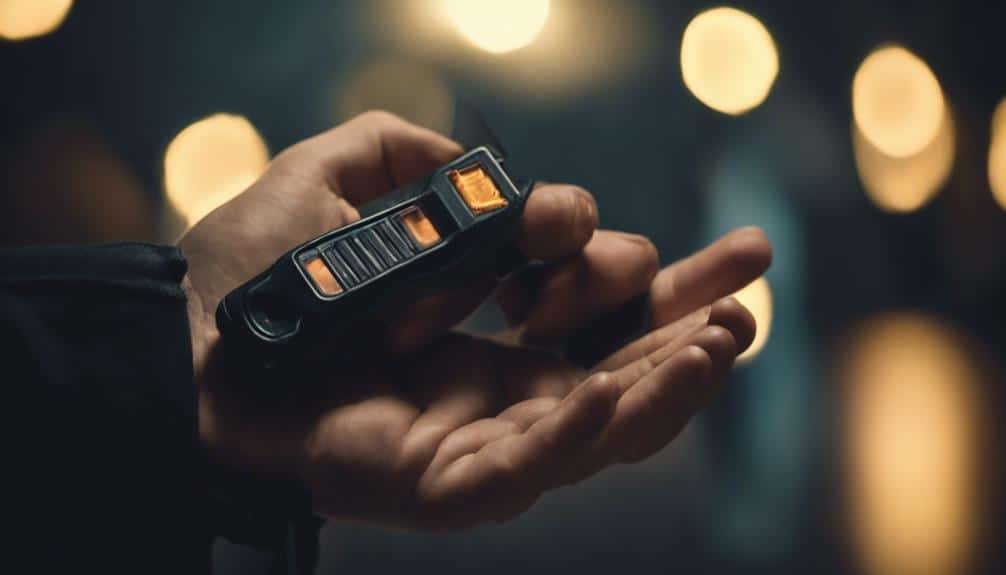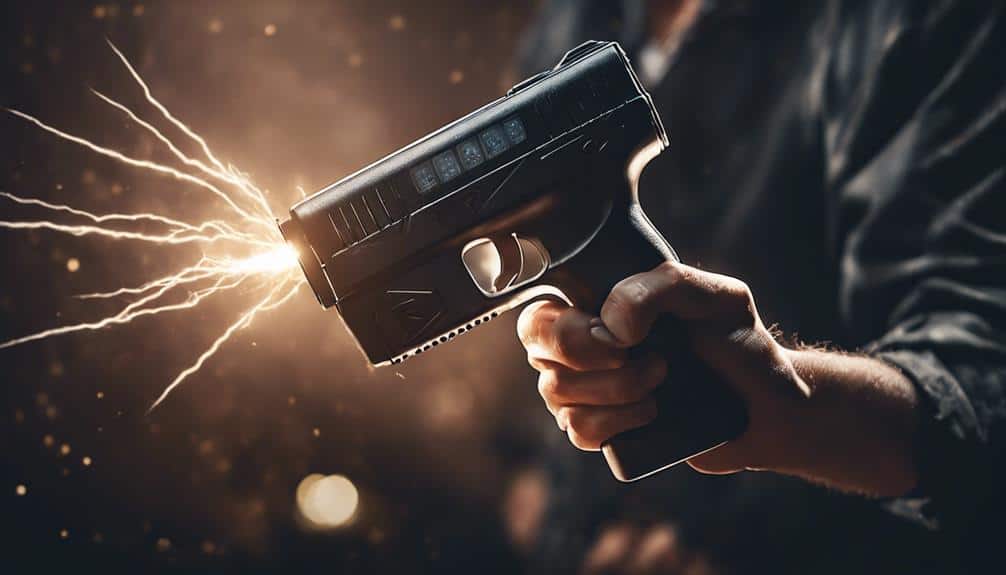Ah, the stun gun: humanity’s attempt at pacifism with a spark. You might think it’s just a tickle party for attackers, but there’s more beneath the surface.
While it’s designed to hinder rather than decorate a tombstone, the question lingers like an uninvited guest: can a stun gun kill a human? The answer isn’t as shocking as the device itself, but it’s tangled in a web of ‘it depends,’ ranging from the individual’s health to the circumstances of use.
If you stick around, you’ll question the lethality and the responsibility of wielding such power.
Key Takeaways
- Stun guns (Tasers) can be lethal, leading to over 100 deaths linked to their use.
- Factors like high voltage, preexisting health conditions, and drug use increase fatality risk.
- Proper aim away from the chest and adherence to safety guidelines reduce lethal outcomes.
- Scientific studies confirm a rare but real connection between stun gun shocks and cardiac arrest.
Understanding Stun Guns

Delving into the workings of stun guns, you should know they emit between 2-5 milliamps of current, far below the potentially fatal threshold. This amount of current, while not deadly, is enough to cause significant pain and muscle contractions.
These effects lead to temporary incapacitation, a feature that’s made stun guns a popular choice among police departments. The goal is to subdue a suspect with minimal harm, reducing the risk of officer injuries and ensuring safer interactions in tense situations.
Stun guns are designed to hinder by inducing pain and fatigue without causing long-term physical damage. This balance is vital in law enforcement, where the aim is often to neutralize a threat without causing unnecessary harm.
The high-voltage shocks temporarily disrupt muscle functions, providing officers with a window to take control of the situation. By focusing on non-lethal methods, police departments can effectively manage encounters, maintaining safety while minimizing the potential for injury to officers and individuals involved.
This approach protects the public and reduces the likelihood of officers sustaining injuries during confrontations.
Factors Influencing Lethality
Stun guns are designed to incapacitate without causing long-term harm, but several factors can influence their potential lethality. The high voltage associated with Tasers affects individuals differently. The risks are significantly higher if someone has a fragile health condition, is of advanced age, or is highly vulnerable to electrical shocks.
The duration and intensity of the shock are also crucial. A quick zap may disorient, but prolonged or repeated shocks can push the body beyond its limits. Mixing stun gun shocks with substances like alcohol or drugs is extremely risky. These substances can amplify the body’s reaction, increasing the chances of severe outcomes.
If someone has a preexisting heart condition or any medical vulnerability, a stun gun can quickly become potentially fatal. Proper training, adherence to safety guidelines, and awareness of these risks are essential for anyone using a stun gun. This knowledge is not only crucial for using the tool effectively but also for preventing potentially deadly situations.
Real-Life Incidents

Reports show that over 100 deaths have been linked to stun gun use, including fatalities from Tasers. This alarming statistic raises concerns about the use of Tasers by law enforcement and whether they can indeed kill a person. In several instances, tasers have been identified as the cause or a contributing factor to the death of individuals following their deployment, pointing to a critical need for scrutiny and reevaluation of their use in policing.
| Factor | Impact on Fatalities |
|---|---|
| Excited Delirium | Cited in coroner reports as a potential factor in deaths |
| Sudden Deaths | Rise noted in California following taser deployments |
| Police Protocols | Aim to reduce fatalities through proper training and guidelines |
Coroner reports often mention excited delirium, which makes determining the exact cause of death in these cases quite complex. Additionally, the increase in sudden deaths after Taser deployments in California highlights the potential risks associated with their use.
Law enforcement agencies have established specific protocols to reduce these risks, focusing on proper training and following guidelines. However, the question remains: Can a stun gun kill a person? Evidence suggests that, in certain situations, it can.
Scientific Studies Overview
When it comes to scientific studies, researchers have shown that stun guns can be fatal in certain situations. While many view them as non-lethal devices, there is evidence that, in rare cases, they can result in death. Studies have identified over 100 potential fatalities associated with Taser, not stun gun usage, raising concerns about their safety. One concerning discovery is the link between stun gun shocks and cardiac arrest.
It has been found that using stun guns, mainly when shocks are directed at the chest, can potentially trigger a cardiac event. Not every shock will lead to a negative outcome, but it emphasizes a risk that should not be overlooked. Experts emphasize the importance of avoiding chest shots with stun guns to ensure safety for yourself and others.
If you find yourself in a situation where a stun gun is being used, it is crucial to know what to do in case of an emergency, mainly if someone displays signs of cardiac arrest. Being prepared and acknowledging the potential dangers associated with these tools is critical to staying safe.
Safety Guidelines and Recommendations

To reduce the risk of lethal outcomes, make sure to aim stun guns at non-lethal areas of the body. This dramatically lowers the chance of causing fatal harm. Avoid targeting sensitive regions like the face to prevent serious injuries or death.
Always be aware of the power you’re dealing with when using a stun gun. Regularly check your device for malfunctions to ensure it works as intended, keeping you and others safe. By staying vigilant, you can guarantee that the stun gun is safe and effective when needed.
Keep stun guns out of reach of children to prevent accidental harm or misuse. It’s crucial to store these devices securely to avoid any unwanted incidents.
In selling stun guns for over 30 years, I have never known of a civilian stun gun killing or permanently harming someone. The deaths attributed to Tasers have all been law enforcement-related.
Frequently Asked Questions
Will a Stun Gun to the Heart Kill You?
If a stun gun hits you in the heart, its electrical impact could exploit the heart’s vulnerability, potentially causing fatal rhythms. While not always lethal, it’s risky and could indeed be deadly.
Can a Taser Kill You if Shot in the Head?
If you’re shot in the head with a Taser, the brain effects can be severe and potentially fatal. You’re also looking at legal consequences for whoever uses it that way, as it’s incredibly dangerous.
Does a Stun Gun Knock You Out?
No, a stun gun won’t knock you out. It’s designed to cause intense pain and muscle spasms, lowering your pain tolerance and controlling your movements through pain, not by making you lose consciousness.


